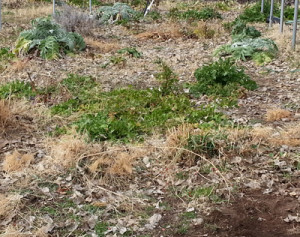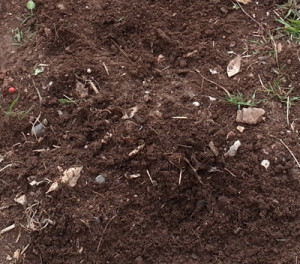Lasagna Gardening
At the request of three people, I’m posting the official Farm on Oak Creek how-to guide for building a Lasagna Garden. No, this is not a garden that contains basil, tomato, sausage and noodle plants. But it is a great way to build a quick and very fertile garden ON TOP of everything from Caliche to our local red adobe clay soil to concrete. Yes, you can grow a garden on your driveway if you so choose. I’ve actually built one of these on concrete. I had lovely herbs, radishes and onions in it, then the Javelina came through and had an equally lovely feast. The next one was lined with Lavender. They never touched it and I had enough flowers from the Lavender to make Lavender syrup.
I continue to use this “recipe” here on the farm. Almost six years ago now, when I first arrived, I hooked the massive rototiller attachment to the ancient John Deere and made a valiant effort to till the soil near the barn. The tines of the rototiller BOUNCED off the ground. That’s how sun-beaten and compacted–and dead–my soil was. No sweat. I’d been building this layered, instant garden for years in Scottsdale because, well, I’m impatient. I was laying out four foot wide by eight foot long garden beds at the time. It was far more satisfying to build an instant garden than working to build my soil, which can take a couple of years.
After the rototiller incident, I decided to go the same Lasagna route since I wanted–no, needed a garden right away. Never mind that the space was forty feet long by twenty feet wide. After all, what else was I going to do with a whole house’s worth of moving boxes that had to be disposed of?
Because I was doing such a massive space, I didn’t bother with creating rows by framing the beds. You’ll probably want frames if you’re doing a small space. They can be made of wood or whatever you have at hand. All you’re trying to do with a frame is to contain the garden, which has a tendency to slide a little at first, especially around rambunctious dogs and kids. Don’t worry about building the frames as tall as the garden. The contents will swiftly begin to decompose and as it does it flattens significantly.
As with any garden, choose your spot well. The amount of light your plants get is important. Out here in the desert Southwest, midday and afternoon shade is good while in cloudier places, making sure the garden gets lots of light is important. If you don’t know much about gardening, I recommend you talk to your local county Extension office. Chances are, they’ll have the information you need right at their fingertips. Most Extension offices even offer gardening classes.
Building the garden requires cardboard, newspaper, bone meal, blood meal, enough alfalfa to cover the size area you’ve chosen with a single layer of flakes, which should be about 3 inches tall, enough straw to cover the area with 9 inches of straw, or 3 layers of 3 inch flakes and, lastly, 3 inches of compost. For you city folk, you can buy bales of straw and alfalfa at a feed store–and there will be feed stores in your area even if you’ve never noticed them, what with all the new urban home chicken and goat owners around. Do what you can to find straw that hasn’t been too saturated with pesticides and herbicides. You definitely want to avoid straw made from cotton plants. Those suckers are seriously toxic. The same goes for alfalfa. The most recent numbers I’ve read is that about 69% of alfalfa in the US is now GMO. That means lots of Roundup in your garden, which is definitely a threat to the roots of your new seedlings. If you can’t find alfalfa that you like, check for bales of oat or barley, or a mix of those, or even an orchard grass. None of those are GMO (not enough money in it). Also, don’t use compost made from sewer sludge. So much toxic stuff still makes it through the composting process, including residues from all sorts of pharmaceuticals. If you don’t know how or from what the bag of compost you found at the big box store is made, ask. If the answer is “I don’t know”, you might want to check with your local rock supplier. They often have bulk compost for landscapers and will sell you a tub or two. And, these days, there are a lot more people making compost for sale from landscaper leavings. Check at your local farmers’ market or look on-line for a local Permaculture group. Permies are a great source for all sorts of natural garden ingredients. THIS IS IMPORTANT! DON’T SKIP THIS: Wet down your compost before you put it on your garden. It doesn’t have to be completely soggy, but it must be damp. As wet as a damp sponge would be good. If compost goes on dry, it will stay dry and everything you plant in it will suffer. If it goes on damp, it will retain water. It will retain even more water if you mulch the surface of your garden after you put your plants in. You can use leftover straw as a mulch if you have it.
So here’s how to build your instant garden. Lay out your flattened cardboard boxes to fill the space you’ve chosen. Cover them with a layer of newspaper. Sprinkle generous handfuls of bone meal and blood meal over the newspaper. Then, tear into that bale of alfalfa. It will come apart in squares. That’s a flake. Lay out a single layer of alfalfa flakes. Top that with three layers of straw flakes. Cover the last layer of straw with 3 inches of your damp compost. Water it well, then start popping in your purchased seedlings. Yes, it can be the same day or even in the same hour you finished building the garden. I don’t recommend trying to start seeds in this as for the first few weeks it gets a little hot as the garden gears up, and you really won’t be able to keep it wet enough to start seeds.
 And what happened to that massive first Lasagna garden of mine? It’s now decomposed to ground level. The dirt is a gorgeous brown and filled with mycorrhizae, fungal forms that feed my plants. Right now, it looks pretty tatty, but I’ve been harvesting arugula, chard, parsley and fennel out of it all winter. I finally cut back the asparagus that I intend will someday fill it from one end to the other. I’m about halfway there. Asparagus all spring is a great way to get rid of moving boxes.
And what happened to that massive first Lasagna garden of mine? It’s now decomposed to ground level. The dirt is a gorgeous brown and filled with mycorrhizae, fungal forms that feed my plants. Right now, it looks pretty tatty, but I’ve been harvesting arugula, chard, parsley and fennel out of it all winter. I finally cut back the asparagus that I intend will someday fill it from one end to the other. I’m about halfway there. Asparagus all spring is a great way to get rid of moving boxes.

